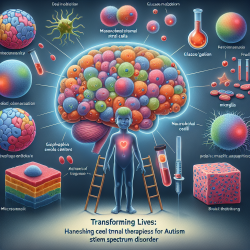Autism Spectrum Disorder (ASD) presents a myriad of challenges, from impaired social communication to repetitive behaviors. As the prevalence of ASD continues to rise, so does the urgency to develop effective treatments. A recent review, "Cell Therapies for Autism Spectrum Disorder Based on New Pathophysiology," offers promising insights into the potential of cell therapies to transform the landscape of ASD treatment.
Understanding the Research
The review highlights the relationship between ASD and neuroinflammation, microglia dysfunction, and glucose metabolism abnormalities. It synthesizes findings from ten clinical studies on cell therapies, such as umbilical cord blood cells, bone marrow mononuclear cells, and mesenchymal stromal cells, showing promising outcomes with minimal adverse events.
Key Findings
- Neuroinflammation and Microglia: Abnormal microglial activation and neuroinflammation are critical in ASD pathology. Modulating microglial function could offer a new therapeutic avenue.
- Glucose Metabolism: ASD is associated with altered glucose metabolism, suggesting that therapies improving metabolic function could benefit individuals with ASD.
- Cell Therapies: Clinical trials using various cell types (e.g., umbilical cord blood cells, mesenchymal stromal cells) have shown improvements in cognitive and behavioral symptoms without significant adverse effects.
Implications for Practitioners
For practitioners, these findings underscore the importance of staying abreast of emerging therapies. Incorporating cell therapy into treatment plans may enhance outcomes for children with ASD. Practitioners are encouraged to:
- Stay Informed: Regularly review the latest research on cell therapies and ASD.
- Collaborate: Work with multidisciplinary teams to integrate cell therapies into comprehensive treatment plans.
- Advocate: Support further research and clinical trials to expand the evidence base for cell therapies in ASD.
Conclusion
The integration of cell therapies in ASD treatment represents a significant shift towards more effective interventions. By understanding and applying these innovative approaches, practitioners can help improve the lives of children with ASD.
To read the original research paper, please follow this link: Cell Therapies for Autism Spectrum Disorder Based on New Pathophysiology: A Review.










